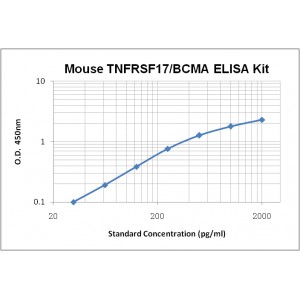More info
Assay Range | 31.2-2,000 pg/mL |
Sensitivity | 10.0 pg/mL |
Specificity | No cross-reaction with other related substances detected |
Size | 96T |
Storage | Store at 2 - 8ºC. Keep reconstituted standard and detection Ab at -20 ºC |
Assay Principle | Sandwich ELISA |
Sample Volume | 100 µL final volume, dilution factor varies on samples |
Detection Method | Chromogenic |
Kit Components
1. Recombinant Mouse TNFRSF17 standard: 2 vials
2. One 96-well plate coated with Mouse TNFRSF17 Ab
3. Sample diluent buffer: 12 mL - 1
4. Detection antibody: 130 µL, dilution 1:100
5. Streptavidin-HRP: 130 µL, dilution 1:100
6. Antibody diluent buffer: 12 mL x1
7. Streptavidin-HRP diluent buffer: 12 mL x1
8. TMB developing agent: 10 mL x1
9. Stop solution: 10 mL x1
10. Washing solution (20x): 25 mL x1
Background
BCMA (B cell maturation antigen), also known as Tumor necrosis factor receptor superfamily member 17 (TNFRSF17), B-cell maturation protein, or CD269, is a type III membrane protein belonging to the TNFRSF family. Mouse BCMA is a 185 amino acid (aa) protein composed of a 49 aa extracellular domain with a cysteine rich fragment, a 23 aa transmembrane domain, and a 113 aa intracellular domain. Mouse and human BCMA share 62% amino acid identity. BCMA is the closest homolog of TACI in the TNFRSF family, both of them are capable of binding to APRIL and BAFF, members of the TNF ligand superfamily. BCMA is expressed in immune organs and mature B cell lines and has been shown to exist in the Golgi compartment. Interaction of BCMA with APRIL or BAFF can stimulate IgM production in peripheral blood B cells and increase the survival of cultured B cells, suggesting that BCMA may play an important role in B cell development and functionality.


